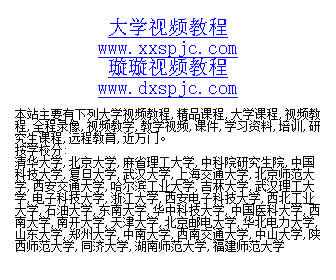第一本:Biochemistry 生物化学 第五版 2002
by Jeremy M. Berg,John L. Tymoczko,Lubert Stryer

纳米盘SkyDrive永久链接:http://d.namipan.com/sd/378084
简介:
Stryer 的《Biochemistry》在国际生物化学界颇富盛名。至上个世纪90年代中期(第4版)已经印刷、发行了12种语言的版本。该书由W. H. Freeman and Company 出版发行。2007年,该出版社出版了最新的版本(第6版)
该书第5、6版由Jeremy M. Berg、 John L. Tymoczko和Lubert Stryer共同完成。此前的第1~4版由Lubert Stryer独立完成。
本书为第五版,适用于大学基础生物化学课程。本书以简洁、明了的方式,介绍了生物化学的各个主要范畴,和一些新近的发现,主要的课题包括:生物分子的结构 与功能、生物信息学、酶的结构与催化关系、细胞内物质的运输与讯息传递、新陈代谢、分子生物学、部分生理过程的生化基础,及药物研发。本版的一大特点,是 强调了生物化学和生物功能的联系。本书附有大量彩图,有助读者理解生化过程及生物分子的结构。本版新增的生物分子结构图,附有图说,简洁地指出结构中的关 键特征。
作者简介:
Lubert Stryer(卢伯特•斯拽尔)博士在美国科学院院士、斯坦福大学细胞生物学任Winzer教授(文泽尔教授),是斯坦福大学医学院和神经生物学兼职教 授。他是2006年8名美国国家科学技术奖获得者之一。此外,Stryer博士还曾获得“生物化学基础研究Eli Lilly奖”、“知识产权所有人协会杰出发明者奖”等很多奖项。其父系德国人,年轻时远渡重洋、到中国做生意;1937年结婚,次年(1938 年)Stryer在天津出生。Stryer毕业于芝加哥大学,在哈佛医学院取得博士学位(MD)。1976年9月受聘于斯坦福大学医学院任Winzer教 授,1993年9月兼任神经生物学教授。1984年入选美国科学院院士。他现在还是两个生物技术公司——Affymax和Senomyx Inc——科学顾问委员会的主席和McKnight Endowment 神经科学基金会成员。1975年,Stryer博士在出版了第1版《Biochemistry》后开始教授生物化学。
目录:
I. The Molecular Design of Life
1. Prelude: Biochemistry and the Genomic Revolution
2. Biochemical Evolution
3. Protein Structure and Function
4. Exploring Proteins
5. DNA, RNA, and the Flow of Genetic Information
6. Exploring Genes
7. Exploring Evolution
8. Enzymes: Basic Concepts and Kinetics
9. Catalytic Strategies
10. Regulatory Strategies: Enzymes and Hemoglobin
11. Carbohydrates
12. Lipids and Cell Membranes
13. Membrane Channels and Pumps
II. Transducing and Storing Energy
14. Metabolism: Basic Concepts and Design
15. Signal-Transduction Pathways: An Introduction to Information Metabolism
16. Glycolysis and Gluconeogenesis
17. The Citric Acid Cycle
18. Oxidative Phosphorylation
19. The Light Reactions of Photosynthesis
20. The Calvin Cycle and the Pentose Phosphate Pathway
21. Glycogen Metabolism
22. Fatty Acid Metabolism
23. Protein Turnover and Amino Acid Catabolism
III. Synthesizing the Molecules of Life
24. The Biosynthesis of Amino Acids
25. Nucleotide Biosynthesis
26. The Biosynthesis of Membrane Lipids and Steroids
27. DNA Replication, Recombination, and Repair
28. RNA Synthesis and Splicing
29. Protein Synthesis
30. The Integration of Metabolism
31. The Control of Gene Expression
IV. Responding to Environmental Changes
32. Sensory Systems
33. The Immune System
34. Molecular Motors
学习网站:http://bcs.whfreeman.com/biochem5/

